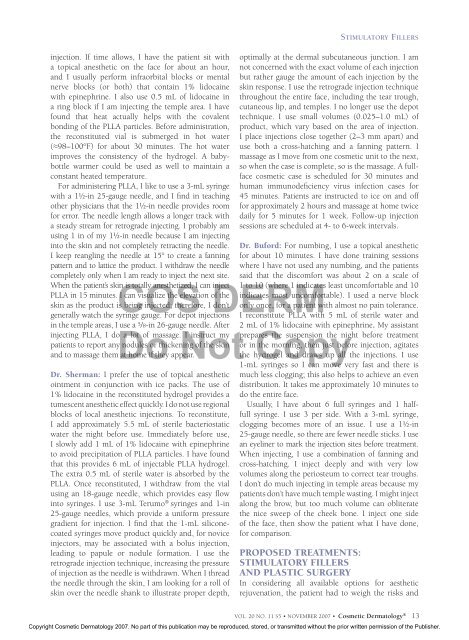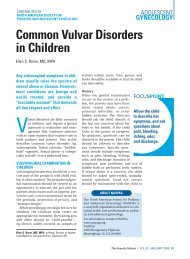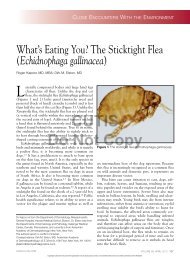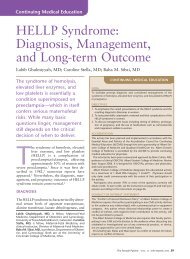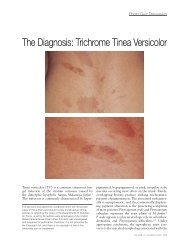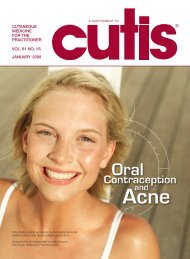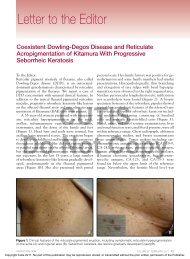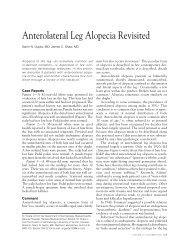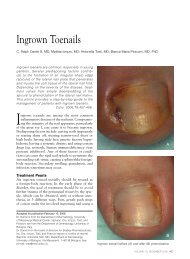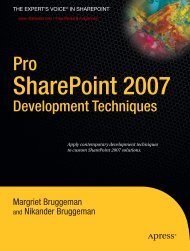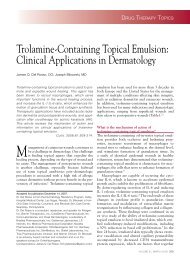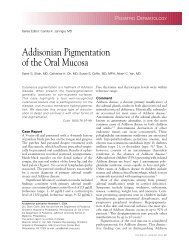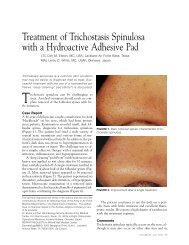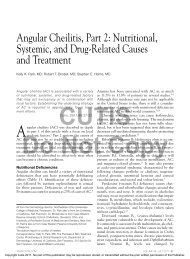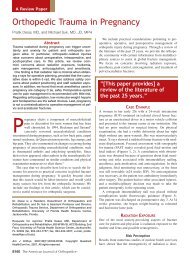The Role of Stimulatory Fillers in Aesthetic Facial Rejuvenation
The Role of Stimulatory Fillers in Aesthetic Facial Rejuvenation
The Role of Stimulatory Fillers in Aesthetic Facial Rejuvenation
Create successful ePaper yourself
Turn your PDF publications into a flip-book with our unique Google optimized e-Paper software.
<strong>in</strong>jection. If time allows, I have the patient sit with<br />
a topical anesthetic on the face for about an hour,<br />
and I usually perform <strong>in</strong>fraorbital blocks or mental<br />
nerve blocks (or both) that conta<strong>in</strong> 1% lidoca<strong>in</strong>e<br />
with ep<strong>in</strong>ephr<strong>in</strong>e. I also use 0.5 mL <strong>of</strong> lidoca<strong>in</strong>e <strong>in</strong><br />
a r<strong>in</strong>g block if I am <strong>in</strong>ject<strong>in</strong>g the temple area. I have<br />
found that heat actually helps with the covalent<br />
bond<strong>in</strong>g <strong>of</strong> the PLLA particles. Before adm<strong>in</strong>istration,<br />
the reconstituted vial is submerged <strong>in</strong> hot water<br />
(≈98–100°F) for about 30 m<strong>in</strong>utes. <strong>The</strong> hot water<br />
improves the consistency <strong>of</strong> the hydrogel. A babybottle<br />
warmer could be used as well to ma<strong>in</strong>ta<strong>in</strong> a<br />
constant heated temperature.<br />
For adm<strong>in</strong>ister<strong>in</strong>g PLLA, I like to use a 3-mL syr<strong>in</strong>ge<br />
with a 1½-<strong>in</strong> 25-gauge needle, and I f<strong>in</strong>d <strong>in</strong> teach<strong>in</strong>g<br />
other physicians that the 1½-<strong>in</strong> needle provides room<br />
for error. <strong>The</strong> needle length allows a longer track with<br />
a steady stream for retrograde <strong>in</strong>ject<strong>in</strong>g. I probably am<br />
us<strong>in</strong>g 1 <strong>in</strong> <strong>of</strong> my 1½-<strong>in</strong> needle because I am <strong>in</strong>ject<strong>in</strong>g<br />
<strong>in</strong>to the sk<strong>in</strong> and not completely retract<strong>in</strong>g the needle.<br />
I keep reangl<strong>in</strong>g the needle at 15° to create a fann<strong>in</strong>g<br />
pattern and to lattice the product. I withdraw the needle<br />
completely only when I am ready to <strong>in</strong>ject the next site.<br />
When the patient’s sk<strong>in</strong> is totally anesthetized, I can <strong>in</strong>ject<br />
PLLA <strong>in</strong> 15 m<strong>in</strong>utes. I can visualize the elevation <strong>of</strong> the<br />
sk<strong>in</strong> as the product is be<strong>in</strong>g <strong>in</strong>jected; therefore, I don’t<br />
<strong>Stimulatory</strong> <strong>Fillers</strong><br />
COS DERM<br />
only once, for a patient with almost no pa<strong>in</strong> tolerance.<br />
generally watch the syr<strong>in</strong>ge gauge. For depot <strong>in</strong>jections I reconstitute PLLA with 5 mL <strong>of</strong> sterile water and<br />
<strong>in</strong> the temple areas, I use a 5 /8-<strong>in</strong> 26-gauge needle. After 2 mL <strong>of</strong> 1% lidoca<strong>in</strong>e with ep<strong>in</strong>ephr<strong>in</strong>e. My assistant<br />
<strong>in</strong>ject<strong>in</strong>g PLLA, I do<br />
Do<br />
a lot <strong>of</strong> massage.<br />
Not<br />
I <strong>in</strong>struct my prepares<br />
Copy<br />
the suspension the night before treatment<br />
patients to report any nodules or thicken<strong>in</strong>g <strong>of</strong> the sk<strong>in</strong> or <strong>in</strong> the morn<strong>in</strong>g, then just before <strong>in</strong>jection, agitates<br />
and to massage them at home if they appear.<br />
the hydrogel and draws up all the <strong>in</strong>jections. I use<br />
Dr. Sherman: I prefer the use <strong>of</strong> topical anesthetic<br />
o<strong>in</strong>tment <strong>in</strong> conjunction with ice packs. <strong>The</strong> use <strong>of</strong><br />
1% lidoca<strong>in</strong>e <strong>in</strong> the reconstituted hydrogel provides a<br />
tumescent anesthetic effect quickly. I do not use regional<br />
blocks <strong>of</strong> local anesthetic <strong>in</strong>jections. To reconstitute,<br />
I add approximately 5.5 mL <strong>of</strong> sterile bacteriostatic<br />
water the night before use. Immediately before use,<br />
I slowly add 1 mL <strong>of</strong> 1% lidoca<strong>in</strong>e with ep<strong>in</strong>ephr<strong>in</strong>e<br />
to avoid precipitation <strong>of</strong> PLLA particles. I have found<br />
that this provides 6 mL <strong>of</strong> <strong>in</strong>jectable PLLA hydrogel.<br />
<strong>The</strong> extra 0.5 mL <strong>of</strong> sterile water is absorbed by the<br />
PLLA. Once reconstituted, I withdraw from the vial<br />
us<strong>in</strong>g an 18-gauge needle, which provides easy flow<br />
<strong>in</strong>to syr<strong>in</strong>ges. I use 3-mL Terumo ® syr<strong>in</strong>ges and 1-<strong>in</strong><br />
25-gauge needles, which provide a uniform pressure<br />
gradient for <strong>in</strong>jection. I f<strong>in</strong>d that the 1-mL siliconecoated<br />
syr<strong>in</strong>ges move product quickly and, for novice<br />
<strong>in</strong>jectors, may be associated with a bolus <strong>in</strong>jection,<br />
lead<strong>in</strong>g to papule or nodule formation. I use the<br />
retrograde <strong>in</strong>jection technique, <strong>in</strong>creas<strong>in</strong>g the pressure<br />
<strong>of</strong> <strong>in</strong>jection as the needle is withdrawn. When I thread<br />
the needle through the sk<strong>in</strong>, I am look<strong>in</strong>g for a roll <strong>of</strong><br />
sk<strong>in</strong> over the needle shank to illustrate proper depth,<br />
optimally at the dermal subcutaneous junction. I am<br />
not concerned with the exact volume <strong>of</strong> each <strong>in</strong>jection<br />
but rather gauge the amount <strong>of</strong> each <strong>in</strong>jection by the<br />
sk<strong>in</strong> response. I use the retrograde <strong>in</strong>jection technique<br />
throughout the entire face, <strong>in</strong>clud<strong>in</strong>g the tear trough,<br />
cutaneous lip, and temples. I no longer use the depot<br />
technique. I use small volumes (0.025–1.0 mL) <strong>of</strong><br />
product, which vary based on the area <strong>of</strong> <strong>in</strong>jection.<br />
I place <strong>in</strong>jections close together (2–3 mm apart) and<br />
use both a cross-hatch<strong>in</strong>g and a fann<strong>in</strong>g pattern. I<br />
massage as I move from one cosmetic unit to the next,<br />
so when the case is complete, so is the massage. A fullface<br />
cosmetic case is scheduled for 30 m<strong>in</strong>utes and<br />
human immunodeficiency virus <strong>in</strong>fection cases for<br />
45 m<strong>in</strong>utes. Patients are <strong>in</strong>structed to ice on and <strong>of</strong>f<br />
for approximately 2 hours and massage at home twice<br />
daily for 5 m<strong>in</strong>utes for 1 week. Follow-up <strong>in</strong>jection<br />
sessions are scheduled at 4- to 6-week <strong>in</strong>tervals.<br />
Dr. Buford: For numb<strong>in</strong>g, I use a topical anesthetic<br />
for about 10 m<strong>in</strong>utes. I have done tra<strong>in</strong><strong>in</strong>g sessions<br />
where I have not used any numb<strong>in</strong>g, and the patients<br />
said that the discomfort was about 2 on a scale <strong>of</strong><br />
1 to 10 (where 1 <strong>in</strong>dicates least uncomfortable and 10<br />
<strong>in</strong>dicates most uncomfortable). I used a nerve block<br />
1-mL syr<strong>in</strong>ges so I can move very fast and there is<br />
much less clogg<strong>in</strong>g; this also helps to achieve an even<br />
distribution. It takes me approximately 10 m<strong>in</strong>utes to<br />
do the entire face.<br />
Usually, I have about 6 full syr<strong>in</strong>ges and 1 halffull<br />
syr<strong>in</strong>ge. I use 3 per side. With a 3-mL syr<strong>in</strong>ge,<br />
clogg<strong>in</strong>g becomes more <strong>of</strong> an issue. I use a 1½-<strong>in</strong><br />
25-gauge needle, so there are fewer needle sticks. I use<br />
an eyel<strong>in</strong>er to mark the <strong>in</strong>jection sites before treatment.<br />
When <strong>in</strong>ject<strong>in</strong>g, I use a comb<strong>in</strong>ation <strong>of</strong> fann<strong>in</strong>g and<br />
cross-hatch<strong>in</strong>g. I <strong>in</strong>ject deeply and with very low<br />
volumes along the periosteum to correct tear troughs.<br />
I don’t do much <strong>in</strong>ject<strong>in</strong>g <strong>in</strong> temple areas because my<br />
patients don’t have much temple wast<strong>in</strong>g. I might <strong>in</strong>ject<br />
along the brow, but too much volume can obliterate<br />
the nice sweep <strong>of</strong> the cheek bone. I <strong>in</strong>ject one side<br />
<strong>of</strong> the face, then show the patient what I have done,<br />
for comparison.<br />
Proposed Treatments:<br />
<strong>Stimulatory</strong> <strong>Fillers</strong><br />
and Plastic Surgery<br />
In consider<strong>in</strong>g all available options for aesthetic<br />
rejuvenation, the patient had to weigh the risks and<br />
Vol. 20 No. 11 s5 • november 2007 • Cosmetic Dermatology ® 13<br />
Copyright Cosmetic Dermatology 2007. No part <strong>of</strong> this publication may be reproduced, stored, or transmitted without the prior written permission <strong>of</strong> the Publisher.


